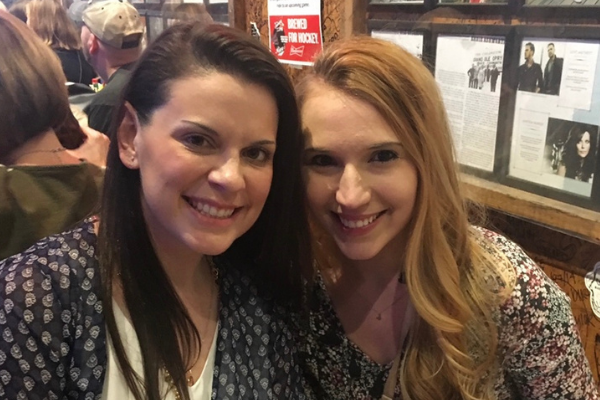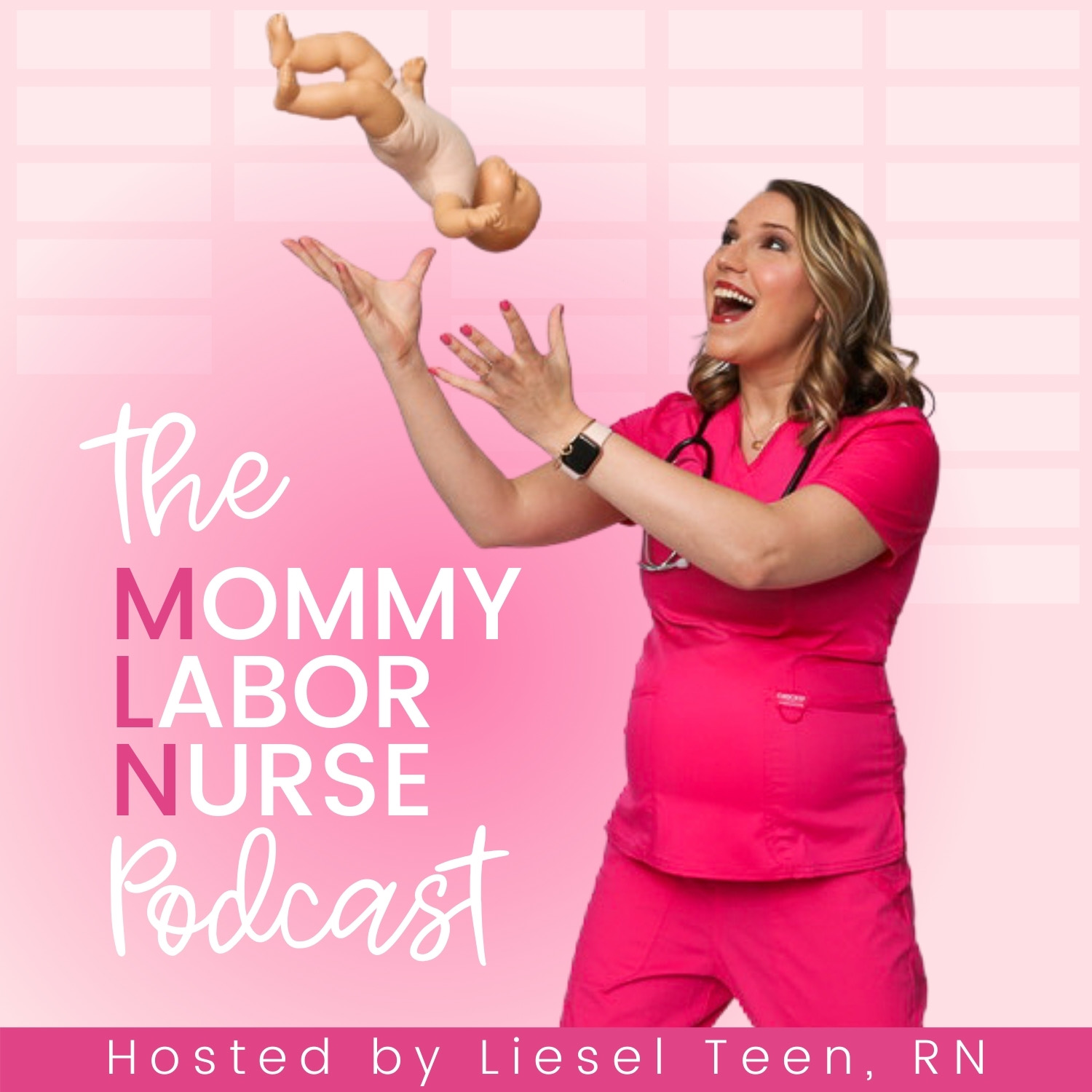Have you ever wondered what it’s like to be a labor and delivery nurse? Wondering how to become a labor and delivery nurse? Or just want to hear more from two labor and delivery nurses that are living the dream?
In this episode of The Mommy Labor Nurse Podcast, my colleague and fellow L&D nurse, Tiffany Tippin, and I discuss all things related to being a labor and delivery nurse.
I know that a number of you in the Mommy Labor Nurse community are interested in nursing and also that as new and expecting mothers many of you are interested in hearing more about the profession, too!
This is an episode we’ve been excited about putting together, so here’s a peek at some of the things we discuss.
- How to become a labor and delivery nurse? (7:11)
- What competencies do you have to keep up as a labor and delivery nurse? (22:38)
- What is an RNC? What’s an RNC in obstetric nursing? (27:39)
- What’s a typical day like on the floor as a labor and delivery nurse? (39:03)
- What’s it like to pump at work as a labor and delivery nurse? (47:33)
- What are different the different units we work in? What is your favorite area within labor and delivery? (50:28)
- What is the best part about being a labor and delivery nurse? (58:40)
- What’s the part about labor and delivery we like the least? (1:14:58)
- Wrapping up our labor and delivery nurse episode (1:18:09)
- About Tiffany and Liesel
- Sponsor: Willow Breast Pump
Follow @mommy.labornurse on Instagram to join our community of over 650k for education, tips, and solidarity on all things pregnancy, birth, and postpartum!
How to become a labor and delivery nurse? (7:11)
If you want to work labor and delivery in a hospital, you’ll need to become an RN (Registered Nurse). And there are a few ways to do this:
- 4 Year University: you’ll go to a traditional university, and graduate with a bachelor’s degree in nursing (BSN)
- Community College: you’ll go to a 2-year tech program or accelerated program (16ish months), and graduate with an associate degree in nursing (ADN)
- Hospital-based diploma program: many states do not offer this type of school anymore-however this is also a way-typically these are 3-year programs.
Once you finish your educational program (regardless of which one)-you’ll have to sit for a licensure exam, the NCLEX! If you pass your NCLEX then you are officially a licensed RN! Now to get a job in labor and delivery…
It’s going to depend on your hospital, but SOME hospitals do offer jobs to new graduate nurses! These jobs are usually very competitive though, and MOST nurses who eventually wind up in L&D work on another floor for a period of time to gain experience, and then transfer!
Some hospitals do NOT offer jobs to new grad nurses, and you’ll need to work 1-2 years of med-surg or on another floor. Labor and delivery is a specialty, so often times managers will only hire nurses with nursing experience!
In the episode you’ll hear more details about this process, and Tiffany and I both share our experiences and paths to labor and delivery. Listen in!
What competencies do you have to keep up as a labor and delivery nurse? (22:38)
You have to maintain your license which is typically done every two years. This depends a bit on how you practice (like full-time, supplemental, etc.), but if you work in a hospital full-time you have to 15 hours of continuing ed every two years.
For labor and delivery and general nursing competencies:
- We have to do containing ed in fetal monitoring every two years,
- Neonatal resuscitation every two years
- Basic life support every two years
- Adult ACL certification every two years.
And then in our hospital specifically (and more and more are doing this!) we also have yearly education and training on topics that our units have determined to be needed or important.
For example, it might be things like postpartum hemorrhages or collecting cord blood.
What is an RNC? What’s an RNC in obstetric nursing? (27:39)
This process is very similar to taking the general nursing NCLEX, except every question in the certification exam is related to labor and delivery. Usually, people do it a few years into becoming an L&D nurse.
Tiffany is an RNC-OB and she explains that you need to maintain this certification every three years. With this certification you also have continuing education associated with that.
For many, the motivation to become an RNC-OB or to get any other specialized certification within L&D nursing is the monetary benefits and credibility.
What’s a typical day like on the floor as a labor and delivery nurse? (39:03)
For this question, Tiffany and I both gave a little rundown of what we do every day, and highlight the differences in working in labor and delivery vs. other units.
The biggest difference we both feel? As a labor and delivery nurse, your entire shift often has a 1:1 focus with a patient. But that isn’t ALWAYS the case at every hospital.
You can hear all the details about a typical day in this episode, and I also encourage you to read my article, A Typical Day in the Life of a Labor and Delivery Nurse – which I reference in the episode, too!
What’s it like to pump at work as a labor and delivery nurse? (47:33)
This isn’t a HUGE part of this episode, but I did want to include it in the show notes, because if you’re a nurse that’s looking for info related to pumping at work, I CANNOT recommend a wearable pump enough.
Yes, you are entitled to pumping breaks, but a wearable pump makes it so much easier and more accessible. A ton of my nursing friends that are breastfeeding moms also swear by this tip.
I use and love the Willow most often these days, but my Freemie Collection Cups also do the trick!
What are different the different units we work in? What is your favorite area within labor and delivery? (50:28)
This is a nuance of labor and delivery that will vary from hospital to hospital depending on the size, types of births, and other specialties. But we go over all the different areas of L&D in our pretty large hospital setting.
The quick rundown is this:
- Working the floor which usually means a patient that’s in active labor or recently delivered
- The operating room (OR) which is generally scheduled c sections
- Antepartum unit which takes care of moms that are having pregnancy complications and need a hospital stay for it
- Obstetric emergency department (OB ED)/Obstetric triage which is for anyone that comes in with an obstetric related complaint to see what’s going on and what care that mama needs
- You can be assigned as “Charge Nurse” for the shift where you don’t really have a specific patient, but you oversee staffing, oversee what’s going on and step in wherever needed (only certain nurses do this roll)
Tiffany’s favorite spots are in the OB emergency department and being the charge nurse for her shifts, and I share that my favorite always used to be triage because it’s fast-paced and you get to see lots of patients.
But these days, since I’ve gone casual, I mostly just work the floor which I also love!
What is the best part about being a labor and delivery nurse? (58:40)
I would say probably what I like most about labor and delivery, like my favorite day, is when I have a first-time mom, and she’s nervous or scared. And she really needs my help and I get to be really supportive. Whether or not she’s trying to go without an epidural or she has an epidural. I just like being needed, and helping a mom get through her first birth.
It’s such a great feeling to be like, “Okay, I really, really supported this mom in her birth and we bonded over 12 hours and now she’s had a baby!” It makes me feel really good and even makes me emotional when her baby finally pops out. The best feeling!
Tiffany actually shares that her favorite aspect of being a labor and delivery nurse is similar! Listen in to hear us discuss this more ?
What’s the part about labor and delivery we like the least? (1:14:58)
Hah. We couldn’t do this episode without including this question! Tiffany explains why the PACU (recovery) is her least favorite spot, and I talk about why emergency situations are really tough for me.
And then in general with hospital nursing the long shifts and early mornings are tough – and we both feel it even more now as working mamas!
Wrapping up our labor and delivery nurse episode (1:18:09)
In the final part of this episode we go over some tips for recent grads or experienced nurses that want to switch over to labor and delivery.
We talk at length about actionable advice, general tips, and even potential interview questions you can prepare for!
About Tiffany and Liesel

For those of you that don’t know me, I’m Liesel Teen, L&D RN, and the founder and owner of Mommy Labor Nurse. My passion lies in educating other moms in that hopes that more women feel empowered and educated for every stage of motherhood – from conception to pregnancy, birth and beyond! I’m a mom to two boys and live in Raleigh, NC.
Tiffany Tippin, BSN, RNC-OB, works in labor and delivery in the same hospital that I do! Aside from that, we are long time friends, and Tiffany is a part of the team here at Mommy Labor Nurse. She’s also a mom to two boys here in Raleigh.
Sponsor: Willow Breast Pump
This episode of the Mommy Labor Nurse podcast was brought to you by Willow. It is no secret that I am in love with my Willow pump! Willow is on a mission to modernize motherhood; the willow pump is the world’s first all-in-one wearable breast pump that fits into your bra giving you the freedom to pump wherever life takes you.
Everything you need to pump is inside with no cords, long tubes, or dangling bottles to hold you back thanks to their no-spill technology. It’s the only wearable breast pump that can be used in any position without milk leaking.
With only four parts to assemble and just two to clean plus an app that tracks your volume in real-time (that might be my favorite part!) you can build your life around your purpose and passion and not your pumping schedule.
So head on over Willow to learn more!





